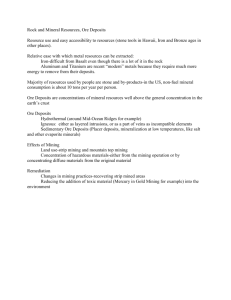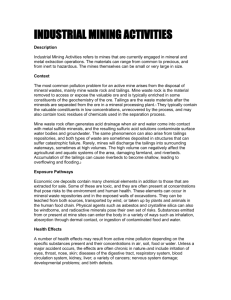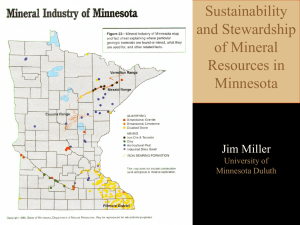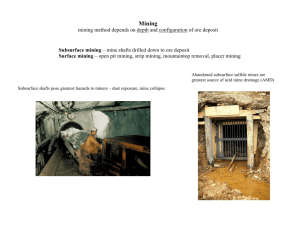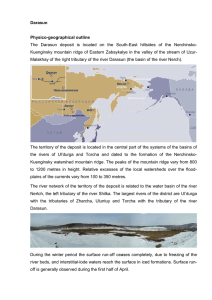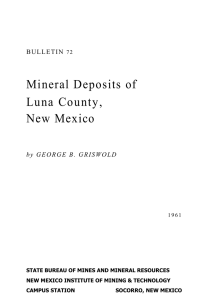Metal Mining: Exploration and Discovery ... Mineral Lodes Geevor
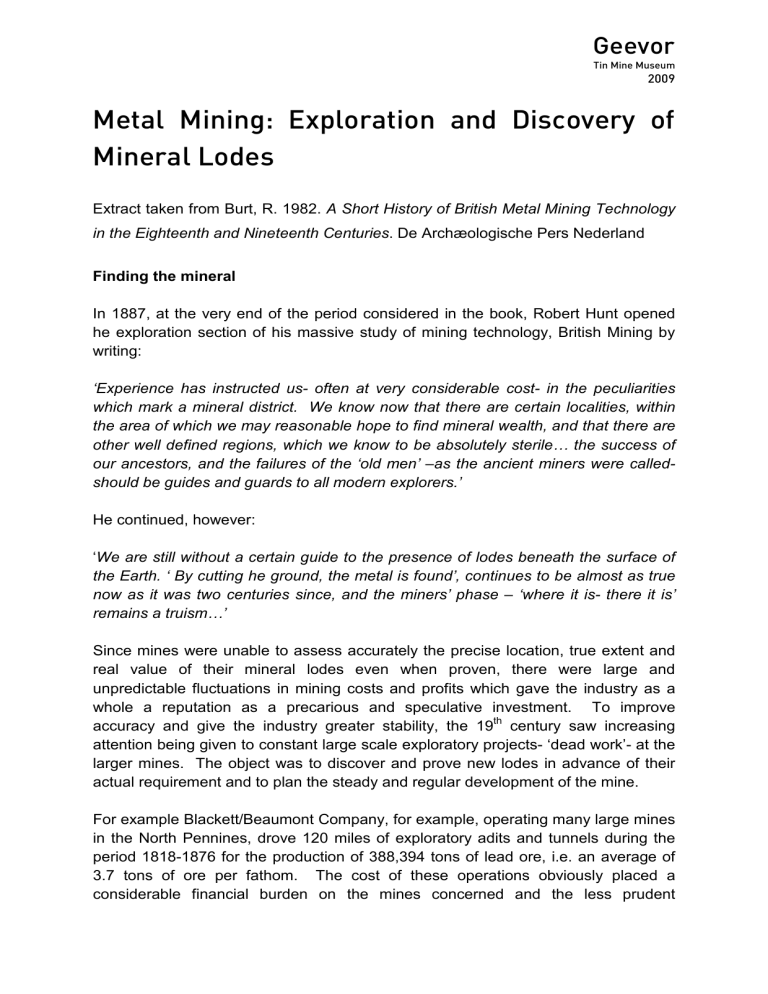
Geevor
Tin Mine Museum
2009
Metal Mining: Exploration and Discovery of
Mineral Lodes
Extract taken from Burt, R. 1982. A Short History of British Metal Mining Technology
in the Eighteenth and Nineteenth Centuries. De Archæologische Pers Nederland
Finding the mineral
In 1887, at the very end of the period considered in the book, Robert Hunt opened he exploration section of his massive study of mining technology, British Mining by writing:
‘Experience has instructed us- often at very considerable cost- in the peculiarities which mark a mineral district. We know now that there are certain localities, within the area of which we may reasonable hope to find mineral wealth, and that there are other well defined regions, which we know to be absolutely sterile… the success of our ancestors, and the failures of the ‘old men’ –as the ancient miners were called- should be guides and guards to all modern explorers.’
He continued, however:
‘We are still without a certain guide to the presence of lodes beneath the surface of the Earth. ‘ By cutting he ground, the metal is found’, continues to be almost as true now as it was two centuries since, and the miners’ phase – ‘where it is- there it is’ remains a truism…’
Since mines were unable to assess accurately the precise location, true extent and real value of their mineral lodes even when proven, there were large and unpredictable fluctuations in mining costs and profits which gave the industry as a whole a reputation as a precarious and speculative investment. To improve accuracy and give the industry greater stability, the 19 th
century saw increasing attention being given to constant large scale exploratory projects- ‘dead work’- at the larger mines. The object was to discover and prove new lodes in advance of their actual requirement and to plan the steady and regular development of the mine.
For example Blackett/Beaumont Company, for example, operating many large mines in the North Pennines, drove 120 miles of exploratory adits and tunnels during the period 1818-1876 for the production of 388,394 tons of lead ore, i.e. an average of
3.7 tons of ore per fathom. The cost of these operations obviously placed a considerable financial burden on the mines concerned and the less prudent
Geevor
Tin Mine Museum
2009 operators frequently chose to forego investment for future development and take high immediate profits instead. Such decisions were favoured by the cost-book form of organisation adopted by many mining companies in the 18 th
and early 19 th centuries, under which all profits were distributed between the partners at regular and frequent intervals. No provision was made for a joint-stock from which long-term capital development projects could be financed. Each major item of expenditure for improving, developing, or maintaining the mine was met by a separate call on the partners in the company, who usually needed to be convinced of its absolute necessity for current operations. From the mid nineteenth century, however, many of the larger adventurers began to bend the rules of cost-book organisation to provide for a continuing stock to finance development work and the rise of joint stock organisation in some areas had a similar effect. Many mineral owners also showed growing concern over the proper development of their property and adapted the terms of their leases to oblige the mining companies to keep sometimes up to onethird of their labour force engaged on development work.
The surface signs of mineralisation looked for by prospectors varied from finding pieces of ore; the discovery of certain mineral waters; the surface outcrops of a vein sometimes uncovered by the action of a stream or a plough; the discovery of metallic sands; the discoloration of tress and grass and peculiar growth patterns’ and the breaking out of water or warm gases. Where no such external evidence was available but the country ‘looked right’, or where underground working was already being conducted, exploration might still continue by making assumption about the continuation of a known lode. For this purpose it was usual to ‘cut the ground’ by sinking exploratory pits, shafts or driving adits. Many districts also had strong traditions of ‘ore divining’ which continued late into the 19 th
century. Several reputable authorities, from Agricola through William Pryce to Robert Hunt referred to the use of these devices as a serious method of investigation. During the 18 th century, with its interest in finding technical application for scientific advances, as least one suggestion was made by D.W Linden in the 1740’s to improve the technique by developing a ‘lead magnate’.
Proving Discovered Lodes
The methods used or proving mineral lodes after their discovery varied between areas depending on local conditions. In districts such as Derbyshire, where the deposits outcropped at or near the surface, it was usual to open trenches along the length of the vein. This technique had the advantage of exposing the general surface branch veins, it assisted in tracing back the vein complex to the main lode.
Also, once opened the trenches served for the initial shallow working of the lodes.
Down to the 17 th
century most of the mines in Derbyshire and many other districts of
Britain consisted of little more than open trenches cut along the vein, with diversions to trace cross, branch, or parallel veins. The method was still in use for smaller
Geevor
Tin Mine Museum
2009 workings in the Pennine and South Western districts as late as the end of the 18 th and early 19 th
century, being clearly described by James Pilkington in the late 1780s and John Farey in 1811. The trenches were cut downwards by miners working with matlocks, picks, hammers, and iron wedges to loosen the ore and spar, throwing the latter onto a bank on each side of the vein. With the aid of ‘stowses’, simple hand winches similar to those at the top of a well, this process continued until a vertical trench, the width of the vein, had been driven several fathoms deep.
At this point, to spare the increasing effort and expense of drawing all the vein stuff, i.e. ore and spar, from a deepening trench, the miners began to construct platforms – stopes or burnings above their heads on which to throw the waste material from the workings and leave only the ore for hauling to the surface. The platforms were made by laying planks along he horizontal props, ‘stulls’ or ‘stempels’ keeping the trench apart and created the impression of the miners filling he workings in upon themselves. At the surface, the waste heaps previously spread uniformly along the sides of he trench now became concentrated around the stowses, creating the nucleus of the later familiar ‘mine hillocks’ . The open trenches continued to be driven downwards to the limit of stability for their side walls or until they reached the water-table and drainage became a serious problem. Sometimes, as at Riber mine in Derbyshire, horizontal pillars of rock were left, too, to help support the side walls and , occasionally, to hold back the water.
In districts like the North Pennines and Cardiganshire, where the mineralisation was relatively shallow and the surface relief was heavily broken, ore lodes often outcropped along the sides of the valleys. In such circumstances he deposits were proved by horizontal levels, slightly inclined to permit free drainage, driven along the course of the vein. Upper and lower galleries were then developed for the extraction of the ore. During the course of these operations, miners sometimes broke into cave systems which were used as natural mine galleries.
In those areas where there were no vein outcrops and it was necessary to break the ground to find the ore, three main techniques were employed: hushing. Boring, and driving drifts. Hushing was the oldest of these and was practiced at some time or another wherever the terrain was suitable. The principle of the system was to construct an artificial pond or lake near the t op of a hill or the side of a valley and, when full, to breach the walls and allow a stream to rush down tearing up the soil as it went. This had the two-fold purpose of laying bare the underlying rock and in some cases, where the stream was powerful enough, acting as an extractive process in itself, with the refuse being sorted for pieces of are. As a general practice, however, hushing was extremely slow and inefficient and very damaging to and wasteful of surface resources.
Geevor
Tin Mine Museum
2009
Bore holes were also used from an early date to penetrate top soil of the upper soft part of rock and to test for the existences and character of ore lodes. These early drillings were comparatively shallow and were conducted with simple chisel bits ( see plate 3) or borers which consisted of little more than a hollow pipe with a sharp cutting edge at one end and a cross piece handle at the other. Bore holes could not be used for deep or detailed exploration. Although invaluable from the earliest times in the search for Coal and other bedded minerals, they could easily miss rich unstratified metal lodes. Even the introduction of modern diamond drilling in the late
19 th
century failed to have any dramatic effect on metal prospecting for these same reasons. Andrew Moil concluded, for example:
‘The diamond drill is of great utility in some forms of mining; but as it is, after all, only a means of getting a very small sample out of the rock passed through; and as ore bodies are so very irregular in form and occurrence in most mines, it is not possible generally to use this cheap and rapid substitute for the usual shaft sinking’.
Moil also noted, however, that drills were often useful underground to test the country rock on each side of the regular workings, looking for other lodes or uncharted flooded workings which could be a danger to present mining operations.
This is common practice in modern mines. Short bore holes were also sometimes used as a method of drainage between levels. E.g. in Derbyshire at Hill Carr Slough,
Gregory mine shaft sinking in the 1770s and 1780s, and for ventilation, as at the
Alport Mines in the 1840s.
The drift, or underground level sometimes known as a cross-cut, was more suitable for exploration than the bore hole, since being driven on a horizontal plane it was more likely to encounter the vertically deposited mineral veins. Driven from one underground working to another for exploration in existing mines, or inwards form he side of a valley or hill, these levels served equally well for he underground movement of men and materials or sometimes the drainage of the working galleries. These multiple uses for drifts permitted them to become the mainstay of exploratory activity in all established mining fields by the end of the 18 th
century. Cross-cutting could be supplemented for the vertical investigation of faulted or steeply hading lodes by exploratory ‘sumps’ and ‘rises’. Driven from either the drifts or other working parts of the mine, these could also be used for underground movement or drainage.


